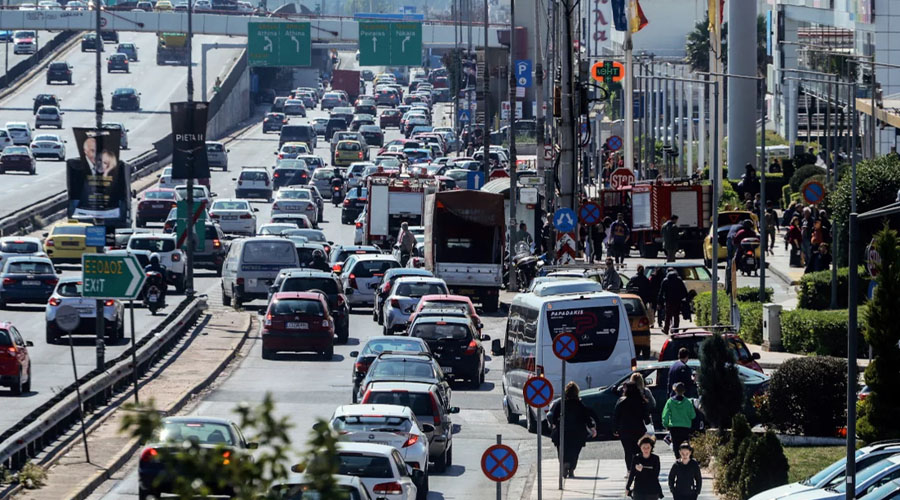What are the main causes of traffic congestion in Athens?
Traffic congestion in Athens has intensified in recent years due to increased demand for travel, especially after the economic crisis and the COVID-19 pandemic. More and more people are choosing to travel in their private cars, creating congestion on the road network, especially during peak hours, which are constantly increasing.
This phenomenon is neither new nor exclusive to Athens and is not expected to improve. Traffic congestion is observed to be increasing in all major cities worldwide and is a long-term challenge. Especially in the European cities with which Athens is often compared, congestion has been a persistent problem for more than three decades and is often more acute than in Athens.
How do you think the situation will evolve in the future and what needs to be done to change the situation on the streets of Athens?
Traffic congestion in Athens will continue to be worsen in the coming years, as is the case in most cities around the world and this will not be changed. In the Science of Traffic, we know that traffic always balances on congestion. No matter how many interventions we make and road infrastructure we build, or how much space we create, the free space will be taken up again by new vehicles.
Therefore, our question is not what to do about congestion and how to accommodate vehicular traffic, but how to better serve travellers in other ways. There may be no solution to traffic, but there is considerable scope for improving the service to travellers if we upgrade sustainable modes of transport, such as public transport for medium and long distances and cycling and walking for shorter distances. As this is the case in most European cities.
What are the most effective solutions that have been implemented in other major European cities and how could they be adapted to the Athenian traffic system?
Improving public transport services can and should be combined with better traffic management measures, such as a complete ban on on-street parking in central non-residential areas (to prevent cars from entering), pricing on-street parking everywhere, reconfiguring intersections, operating lanes only for high-occupancy vehicles, possibly charging for entry into the city center, with the corresponding revenue to support public transport.
Successful examples from European cities have as a common denominator the redistribution of public space at the expense of car traffic and parking and in favor of public transport, cyclists and pedestrians, recently also electric scooters. Athens needs a serious effort to redefine the public space – which currently functions as a warehouse for private cars – through bold and costly interventions on a large scale throughout the road network over a period of 5-10 years, in order to start reversing the current continuously deteriorating transport service.
An additional effective intervention for better and safer traffic operation in the city is the adoption of a 30 km/h speed limit on the entire road network with a few exceptions of major road axes. This measure has already been implemented in many European cities such as Paris, Brussels and Amsterdam with remarkable results both in reducing crashes and fatalities (up to -37%) or air pollution and fuel consumption with a negligible impact on journey times. In addition, in the medium term, it has been observed to lead to an increase in the use of Public Transport as well as in cyclists and pedestrians who are no longer afraid to take to the road. This is a measure with such a high social impact, for such a small change in our habits.
How important is the role of public transport in relieving traffic congestion in Athens, and what measures do you consider necessary for its upgrading?
Public Transport is the only essential solution for the service of travellers in Athens. They will not relieve traffic congestion, because as long as there is space for private cars, they will take up as much space as possible, but they can provide a viable and better alternative for travellers if we give them priority. Only if we commute massively, especially at peak times, can all travellers be better served.
In principle, additional infrastructure is needed in the first instance, primarily on metro lines and in stations, but it will take time to implement. There is also an immediate need to upgrade the three existing metro lines, both to increase frequency and to improve the comfort of travellers (air conditioning). At the same time, however, the bus fleet must and can be renewed relatively quickly, especially with environmentally friendly electric vehicles.
But what buses urgently need today is priority in traffic over all other vehicles. The biggest obstacle to good service by buses today is that they are constantly trapped behind private cars, both circulating and parked. With a sufficient number of bus lanes and free bus lanes, the same number of buses can make up to twice as many journeys at speeds much more competitive than those of cars. Given that the main criterion for choosing a means of transport is time, one can see how many travellers’ buses can attract when given priority.
A decisive role in ensuring bus priority is of course played by systematic and effective policing of the proper operation of bus lanes, with an adequate network of surveillance cameras (including on-board vehicles) and certification of offenders, while automating the process of processing tickets without the current procedural delays. With a serious overall support for public transport, the attractiveness of public transport can be significantly increased and consequently the service for travellers in Athens can be significantly improved and without necessarily very high costs.
How much metro do we need?
The current network of 3 metro lines covers several areas of Athens, but full coverage requires the development of a complete metro network of 8 lines and 200 stations, which should be the first priority in transport infrastructure investments in Athens. There is also an immediate need to upgrade the 3 existing metro lines, both to increase frequency and for travellers’ comfort.
In fact, according to the relevant study by Hellenic Metro, the next lines should be built in the order defined based on the needs to serve the most densely populated areas first. It is therefore necessary to accelerate the development of the next metro lines with rapid tendering and construction procedures, with robust management without the procedural rigidities of the public sector and without the delays of contractors.
In which areas of Athens are there the biggest traffic problems and which infrastructure projects – road works – could alleviate these areas?
Traffic congestion affects most areas of the basin. The situation is particularly acute in the center of Athens, which has been degraded into a transit network (72% of vehicles passing through the center have neither origin nor destination in the centre), Kifissos Avenue, the port of Piraeus, Possidinos Avenue, and Thiva Avenue.
Of course, the major road works proposed by the transport experts must be carried out at last, for better service, especially outside peak hours. The extension of Kymi Avenue, the extension of the Ymittos regional road to the beach, the connection between Biotia and Elefsina, the roads in Mesogeia and the completion of the road rings of the basin must be built. However, it should be noted that in any case, any traffic relief will be temporary and soon after their construction (after 2-3 years), traffic congestion will gradually return, especially during peak hours.
What are the biggest obstacles to the implementation of projects that are talked about but remain on paper?
Unfortunately, Athens is a city that has been abandoned in terms of transport. All the fundamental levels (strategy, tactics, operation) of a proper management of this complex system are missing. A comprehensive strategy is missing for the fundamental choices for the development and operation of the infrastructure and what kind and which projects have priority. The fundamental tactical options for managing public space and prioritising different modes of transport are missing. The tools for implementing the necessary measures are also missing, such as systematic policing with cameras, effective implementation of projects by the Authorities. And of course, both the necessary budgets and the data needed to properly assess the problems and work out appropriate solutions at all levels are missing. Obviously, reversing this neglect needs serious effort over time.
In Athens, the fragmentation of responsibilities between the Ministries of Infrastructure, Environment and Citizen Protection, the Region and the Municipalities (and their agencies) has led to a vicious cycle of inaction and continuous deterioration of the quality of transport and environmental services. Consequently, a serious plan with objectives, actions, budgets and a timetable for the integrated and coordinated development and operation of the transport system of Athens by an effective Metropolitan Body with centralised planning, implementation, management and accountability responsibilities is needed immediately.
Interview on Mononews in December 2024

